Overview of Common Purslane
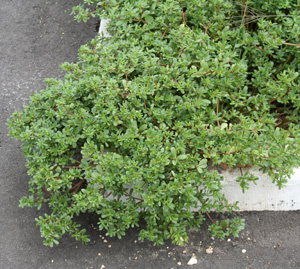
Common purslane, Portulaca oleracea, is a highly variable, weedy plant in the purslane family (Portulacaceae) with a wide distribution. Although it is likely native to North Africa, the Middle East, and the Indian subcontinent, it had reached North America by pre-Columbian times and was in Europe by the late 16th century. Common purslane is now naturalized in most parts of the world, both tropical and temperate – equally at home in flower beds, cultivated fields, and roadsides or other disturbed or waste places. It has been grown for more than 4,000 years as a food and medicinal plant and is still cultivated in many places today.

Common purslane is considered quite nutritious because it is unusually high in omega-3 fatty acids (found mostly in fish and flax seeds) and contains significant amounts of vitamins A and C, as well as calcium, iron, magnesium and potassium and antioxidants. It also contains high amounts of oxalates (just as spinach does) so should not be consumed excessively by those susceptible to forming kidney stones. Common purslane is sometimes used as fodder, fed to poultry to reduce egg cholesterol, and was also used traditionally as an ointment for burns. Some other common names include garden purslane, little hogweed, pusley, and wild portulaca. It’s called pourpier in France and verdolaga in Mexico.
Identification of Common Purslane
Purslane is a fast-growing herbaceous annual with succulent leaves and stems. Even the oblong cotyledons (seed leaves) are succulent. Multiple smooth, reddish stems originating from a single taproot are mostly prostrate, forming a mat covering up to 3 feet in diameter. Depending on the amount of moisture available, common purslane may be very low growing along the soil surface, or more erect, reaching up to 16″ tall.

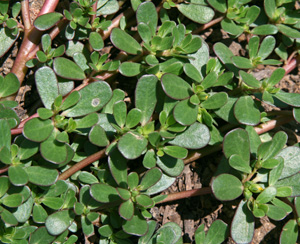
The alternate leaves are clustered at stem joints. Individual leaves are quite fleshy, storing water when available. Each flat green leaf is oval to spoon-shaped, broadest near the rounded tip, and without any indentations along the margin, which may be reddish in color. Leaves rarely have petioles, and are attached directly to the stems.
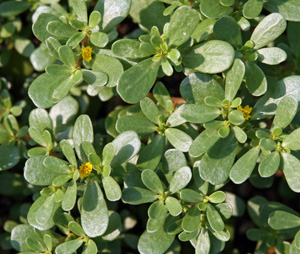
Plants will flower whenever moisture is sufficient. Flowers are ¼ – ½ inch wide and yellow, with five (sometimes four) notched petals, numerous yellow stamens, and several pistils that are bunched together in the center. Common purslane flowers typically only open on hot, sunny days from midmorning to early afternoon. Flowers occur in leaf axils at the stem joints or terminally, with just a single one opening in each leaf cluster at a time.
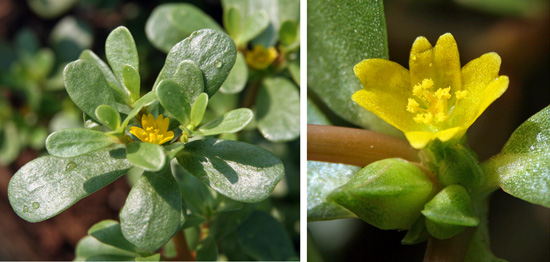
Although pollinators will visit the flowers, the plants are self-fertile, so almost all flowers will go on to produce numerous tiny brown to black seeds in a small pod. When the seeds are mature, the ovoid capsule bursts open along a transverse groove to release its contents.
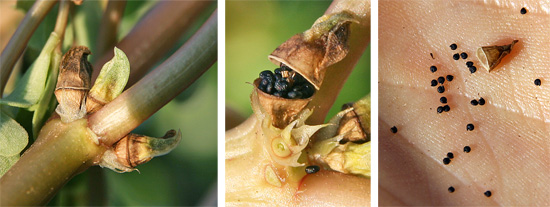
Management of Common Purslane as a Weed
Purslane grows in full sun in almost any soil, from muck soils high in organic matter to heavy clay. It does best in warm weather, and young plants will remain small and stunted when conditions are cool. Although it prefers regular water, it can tolerate drought. It is easily dug or hoed out where unwanted, but these plants should be removed from the garden as cut stems from larger plants will root readily at the nodes to become re-established. Seeds will mature in the pods even if the plant is pulled and left with its roots turned upward. Seeds can remain viable in the soil for several decades. Common purslane will be killed by the first freeze in fall.
General Care of Common Purslane as a Crop
Purslane is easily grown in the vegetable garden from seed, ready for harvest in 6-8 weeks. Sow in fertile, well-drained soil and thin to 4 to 6″ apart. The entire plant can be harvested, or the stems can be cut back to within two inches of the crown and the plant will regrow. This process provides edible leaves for most of the summer, although successive sowings may be preferred for more tender young leaves. When grown as a food crop, water regularly as moisture-stressed leaves are not as palatable as those from well-watered plants. Purslane has few pests, although in some parts of the country purslane sawfly, Schizocerella pilicornis, and a leafminer weevil, Hypurus bertrandiperris, will damage or kill the plants.
In many places outside of North America purslane is commonly eaten as a fresh or cooked vegetable. In the US it can occasionally be found in specialty stores or at Farmer’s Markets.
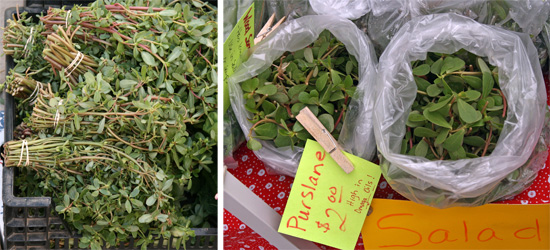
Stems, leaves and flower buds of common purslane have a slightly tart or sour and salty taste. The intensity of flavor is influenced by the physiology of the plant. In hot, dry conditions, purslane switches to photosynthesis using Crassulacean acid metabolism to conserve moisture, with stomata of leaves opening at night, rather than during the day in the normal photosynthetic process, to trap carbon dioxide and convert to malic acid. Malic acid, which has a sour flavor, is converted to glucose for storage during the day. Purslane leaves picked early in the day, when malic acid concentrations are highest, will have the tartest flavor.
Varieties of Common Purslane
There are named purslane cultivars that are grown as crops. They generally have a more upright habit than the wild species, for easier harvesting. Purslane is used in many cuisines around the world, especially in salads, soups, stews, and tomato sauces. When cooked, purslane becomes mucilaginous and acts as a thickener in soups or stews. The seeds are also edible.
- ‘French Green Leaf’ has larger leaves, a more upright growth habit than the wild species, and a mild flavor.
- ‘Golden’ (sometimes called ‘French Gold Leaf’) has large, light green leaves and an upright growth habit.
- ‘Red Gruner’ has an upright habit, red tinted stems, and large leaves. It is sometimes used to produce microgreens.
– Susan Mahr, University of Wisconsin – Madison
Last Update: Bruce Spangenberg, UW-Madison Extension, 2025





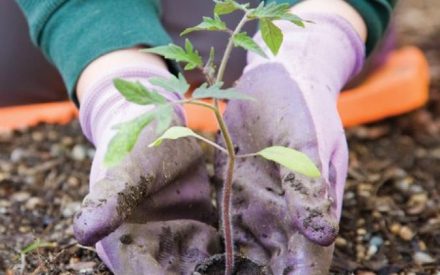 Lead in Home Garden Soil
Lead in Home Garden Soil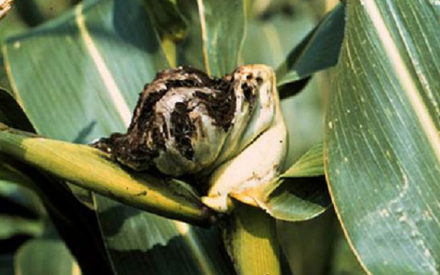 Vegetable Disease Quick Reference
Vegetable Disease Quick Reference Powdery Scab
Powdery Scab


